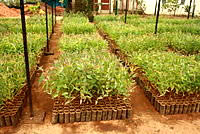
|
|
| Home | About Forestry | Eco-Tourism | Forestry Addresses | FAQs | Contact Us | |
|
| Clonal Forestry | |
TISSUE CULTURE TECHNIQUES FOR TREE SPECIES |
|
Clonal Propagation Conventional methods of asexual propagationv(vegetative propagation) like grafting, budding, layering etc. for many plants and trees are often too slow or fail completely. Microvegetative propagation using tissue culture allows much greater control and manipulation of the development of tissues within the culture tube than conventional methods. In normal cuttings, each cuttings can result in only one plant, whereas by micropropagation thousands of plants can be produced from a single piece of plant tissue explant. Not only is the rate of multiplication increased, but the mean generation time is also decreased because the process can continue all round the year under controlled laboratory conditions. |
 |
|
|
Isolation of Disease-Free Plants Virus infection is a major problem with vegetatively propagated species. Conventional methods of elimination of virus from stock by heat treatment are useful only with some varieties. The growing tip (meristem) is usually uninvaded by viruses and plants obtained by the culture of these meristem tips remains virus free. Morel and Martin (1952) made an first attempt to demonstrate that virus free plants could be produced by culture of apical meristems of dahlia plants. This technique has been exploited to produce virus free plants of fruit trees like citrus, apples, etc. In general, meristem culture results in the production of completely disease free root stocks and other plants. The plants produced have been found to be healthier, more vigorous and to produce higher yields. |
|
| Home | About Forestry | Eco-Tourism | Forestry Addresses | FAQs | Contact Us | |
|
| © All Rights Reserved. TNAU-2016. |
|